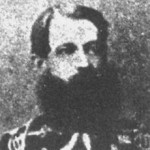top of page
5(c). Heneages at Highcliffe
Neil Bancroft

Captain Clement Walker Heneage
It is a far cry from the peaceful tranquillity of standing beside the font in St Mark’s Parish Church at Highcliffe, to the wild clamour of a headlong cavalry charge through a hail of bullets and shells towards fiercely held enemy positions, but such, on two occasions had been the experience of one Highcliffe resident over one hundred and forty years ago.
The parish register of St Mark’s church contains the entry for the christening of Algernon Walker-Heneage on the 27th March 1871. His father’s name was given as Clement Walker-Heneage of Beacon Lodge and his rank or occupation as “Late Major 8th Hussars”. This gallant soldier, as Captain Heneage, son of George Walker-Heneage of Compton Bassett, Wiltshire, Member of Parliament for Devizes, had been one of the first recipients of the Victoria Cross – the very highest award for outstanding bravery in the face of the enemy, for leading a cavalry charge in the Indian Mutiny.
His citation for the award reads “On 17th June 1858 at Gwalior, India, Captain Heneage – together with Sergeant Joseph Ward, a farrier (George Hollis), and Private John Pearson – was in a gallant charge made by a Squadron of the 8th Hussars when they routed the enemy. Charging through a rebel camp into two Batteries, they captured and brought into their own camp two of the enemy’s guns, under a heavy and converging fire from the fort and town."
The Victoria Cross had only recently been instituted by Queen Victoria, and the medals were originally cast from the bronze of a Russian cannon captured in the Crimean War. It was all the more appropriate therefore that for his bravery Clement Heneage should receive this award, for as a Lieutenant he had experienced his first baptism of fire in that conflict, having actually taken part in the Charge of the Light Brigade. This famous heroic blunder at the battle of Balaclava, celebrated by Tennyson in his dramatic poem, occurred when Major General the Earl of Cardigan led a force, including the 8th Hussars, in a charge on the Russian positions, in a glorious but futile attempt to capture their guns.
The charge was against a formidable array of both artillery and infantry, both before them and from the heights on either side. Out of a force of over six hundred men one hundred and eighteen were killed and one hundred and twenty-seven wounded. Lieutenant Heneage possibly survived because the 8th Hussars, alongside the 4th Light Dragoons, were in the rear of the formation, behind the 11th Hussars, 13th Light Dragoons and the 17th Lancers.
On his retirement from the army, Major Heneage and his family were living at Beacon Lodge, a large house near Highcliffe cliff-top and due south of the present Hinton Oak pub on Lymington Road, but it is not known for exactly how long they were living there. On the death of his father, Clement and family took up residence at Compton House, the family seat at Compton Bassett, where he was born, and in the 1881 census taken there, the place of birth of his three children listed, Algernon 10, Claude 5 and Alice 3, is given as “Hants, Beacon Lodge”, but in the 1891 census it is given for the three of them as “Hampshire, Newtown”, an old name for Highcliffe.
Algernon, the son born at Beacon Lodge in 1871, himself went on to a distinguished service career, but unlike his father his was in the Royal Navy. He joined the battleship HMS Triumph as a midshipman and then served in HMS Royal Arthur in the Pacific. He gained rapid promotion, becoming a Commander in 1900 and was a very early specialist in anti-submarine warfare. At the beginning of World War I he took command of the battleship HMS Albion and was twice mentioned in despatches for his work in supporting the landings at Gallipoli. He was promoted Vice Admiral in 1923 and Admiral in 1927.
bottom of page
